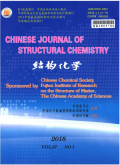Syntheses, Crystal Structures and Antibacterial Activities of Copper(Ⅱ) and Zinc(Ⅱ) Complexes Based on (E)-4-fluoro-2-((3-morpholinopropylimino)methyl)phenol
基本信息来源于合作网站,原文需代理用户跳转至来源网站获取
摘要:
Two Schiff base complexes [Cu(L)2] (1) and [Zn(L)2]·3H2O(2) of (E)-4-fluoro-2-((3-morpholino propylimino)methyl)phenol (HL) have been synthesized and characterized by elemental analysis and single-crystal X-ray diffraction. Crystal data for 1: triclinic, space group Pī with a=4.8000(10), b=11.109(2), c=13.921(3),α=66.55(3),β=80.35(3),γ=81.09(3)°, V=668.2(2)3 , Z=1, Dc=1.477g/cm 3 , F(000)=311, and the final R=0.0744 and wR=0.1601 for 2301 observed reflections with I 〉 2σ(I). And those for 2: monoclinic, space group P21 /c with a=14.789(3), b=11.713(2), c=18.846(4),β=107.85(3)°, V=3107.4(11)3 , Z=4, D c=1.389 g/cm 3 , F(000)=1368, and the final R=0.0749 and wR=0.1348 for 5423 observed reflections with I 〉 2σ(I). Both 1 and 2 are four-coordinated complexes, with a square-planar geometry of copper(Ⅱ) in 1 and a slightly distorted tetrahedral geometry of zinc(Ⅱ) in 2. An asymmetric unit consists of only one half of a Cu ion and one L ligand in 1, while an asymmetric unit is composed of one Zn ion, two L ligands and three water molecules in 2. Non-classical C-H···O and C-H F hydrogen bonds play important roles in the formation of a 1D chain of 1, but O-H O and O-H N hydrogen bonds play dominant roles in the self-assembly of a 3D network of 2. The antibacterial activities of 1 and 2 against B. subtilis, S. aureus, S. faecalis, P. aeruginosa, E. coli and E. cloacae have been evaluated by MTT method.

推荐文章
匹配皮卡的CA4DC2-10E3柴油机开发
共轨柴油机
国Ⅲ排放
冷却EGR系统
优化标定
Synthesis of zinc oxide–montmorillonite composite and its effect on the removal of aqueous lead ions
Synthesis
Characterization
Zinc oxide–montmorillonite composite
Adsorption, Pb2+ ions
Adsorption characteristics of copper ion on nanoporous silica
Nanoporous silica
Copper ion
Adsorption
CA4DC2-12E3型柴油机进气道的试验研究
共轨发动机
进气道
性能和排放优化
内容分析
关键词云
关键词热度
相关文献总数
(/次)
(/年)
文献信息
| 篇名 | Syntheses, Crystal Structures and Antibacterial Activities of Copper(Ⅱ) and Zinc(Ⅱ) Complexes Based on (E)-4-fluoro-2-((3-morpholinopropylimino)methyl)phenol | ||
| 来源期刊 | 结构化学 | 学科 | 农学 |
| 关键词 | Schiff碱配合物 抗菌活性 锌离子 晶体结构 合成 苯酚 单晶X-射线衍射 金黄色葡萄球菌 | ||
| 年,卷(期) | 2012,(7) | 所属期刊栏目 | |
| 研究方向 | 页码范围 | 981-986 | |
| 页数 | 6页 | 分类号 | O625.632|S859.796 |
| 字数 | 语种 | 英文 | |
| DOI | |||
五维指标
引文网络
引文网络
二级参考文献 (0)
共引文献 (0)
参考文献 (15)
节点文献
引证文献 (0)
同被引文献 (0)
二级引证文献 (0)
1972(1)
- 参考文献(1)
- 二级参考文献(0)
2007(3)
- 参考文献(3)
- 二级参考文献(0)
2008(1)
- 参考文献(1)
- 二级参考文献(0)
2009(5)
- 参考文献(5)
- 二级参考文献(0)
2010(4)
- 参考文献(4)
- 二级参考文献(0)
2011(1)
- 参考文献(1)
- 二级参考文献(0)
2012(0)
- 参考文献(0)
- 二级参考文献(0)
- 引证文献(0)
- 二级引证文献(0)
研究主题发展历程
节点文献
Schiff碱配合物
抗菌活性
锌离子
晶体结构
合成
苯酚
单晶X-射线衍射
金黄色葡萄球菌
研究起点
研究来源
研究分支
研究去脉
引文网络交叉学科
相关学者/机构
期刊影响力
结构化学
主办单位:
中国化学会
中国科学院福建物质结构研究所
出版周期:
月刊
ISSN:
0254-5861
CN:
35-1112/TQ
开本:
出版地:
福建省福州市杨桥西路155号
邮发代号:
创刊时间:
语种:
eng
出版文献量(篇)
5114
总下载数(次)
0
总被引数(次)
8477
期刊文献
相关文献
推荐文献
- 期刊分类
- 期刊(年)
- 期刊(期)
- 期刊推荐
力学
化学
地球物理学
地质学
基础科学综合
大学学报
天文学
天文学、地球科学
数学
气象学
海洋学
物理学
生物学
生物科学
自然地理学和测绘学
自然科学总论
自然科学理论与方法
资源科学
非线性科学与系统科学
结构化学2022
结构化学2021
结构化学2020
结构化学2019
结构化学2018
结构化学2017
结构化学2016
结构化学2015
结构化学2014
结构化学2013
结构化学2012
结构化学2011
结构化学2010
结构化学2009
结构化学2008
结构化学2007
结构化学2006
结构化学2005
结构化学2004
结构化学2003
结构化学2002
结构化学2001
结构化学2000
结构化学1999
结构化学2012年第9期
结构化学2012年第8期
结构化学2012年第7期
结构化学2012年第6期
结构化学2012年第5期
结构化学2012年第4期
结构化学2012年第3期
结构化学2012年第2期
结构化学2012年第12期
结构化学2012年第11期
结构化学2012年第10期
结构化学2012年第1期

 免费查重
免费查重










